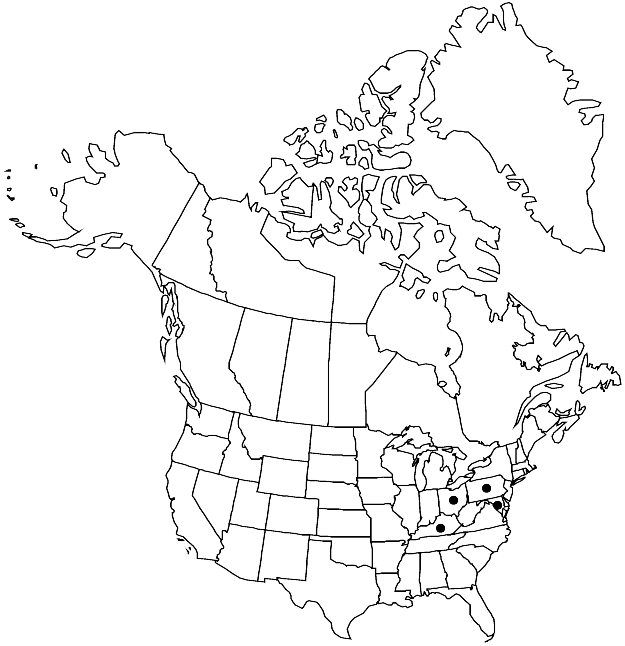Difference between revisions of "Cleome ornithopodioides"
Sp. Pl. 2: 672. 1753.
FNA>Volume Importer |
imported>Volume Importer |
||
| (5 intermediate revisions by 2 users not shown) | |||
| Line 8: | Line 8: | ||
}} | }} | ||
|common_names=Bird spiderflower;Levant mustard | |common_names=Bird spiderflower;Levant mustard | ||
| + | |special_status={{Treatment/ID/Special_status | ||
| + | |code=I | ||
| + | |label=Introduced | ||
| + | }}{{Treatment/ID/Special_status | ||
| + | |code=F | ||
| + | |label=Illustrated | ||
| + | }} | ||
|basionyms= | |basionyms= | ||
|synonyms={{Treatment/ID/Synonym | |synonyms={{Treatment/ID/Synonym | ||
|name=Cleome iberica | |name=Cleome iberica | ||
|authority=de Candolle | |authority=de Candolle | ||
| + | |rank=species | ||
}} | }} | ||
|hierarchy=Cleomaceae;Cleome;Cleome ornithopodioides | |hierarchy=Cleomaceae;Cleome;Cleome ornithopodioides | ||
| Line 27: | Line 35: | ||
|elevation=100-200 m | |elevation=100-200 m | ||
|distribution=Ky.;Md.;Ohio;Pa.;se Europe;sw Asia. | |distribution=Ky.;Md.;Ohio;Pa.;se Europe;sw Asia. | ||
| + | |introduced=true | ||
|tables= | |tables= | ||
|references={{Treatment/Reference | |references={{Treatment/Reference | ||
| Line 41: | Line 50: | ||
-->{{#Taxon: | -->{{#Taxon: | ||
name=Cleome ornithopodioides | name=Cleome ornithopodioides | ||
| − | |||
|authority=Linnaeus | |authority=Linnaeus | ||
|rank=species | |rank=species | ||
| Line 56: | Line 64: | ||
|publication title=Sp. Pl. | |publication title=Sp. Pl. | ||
|publication year=1753 | |publication year=1753 | ||
| − | |special status= | + | |special status=Introduced;Illustrated |
| − | |source xml=https:// | + | |source xml=https://bitbucket.org/aafc-mbb/fna-data-curation/src/2e0870ddd59836b60bcf96646a41e87ea5a5943a/coarse_grained_fna_xml/V7/V7_300.xml |
|genus=Cleome | |genus=Cleome | ||
|species=Cleome ornithopodioides | |species=Cleome ornithopodioides | ||
Latest revision as of 22:32, 5 November 2020
Annuals, 15–60 cm. Stems unbranched or sparsely branched; glandular-pubescent. Leaves: stipules absent; petiole (0.6–)1.5–4.5 cm; leaflets 3 proximally, 1 distally, blade linear to elliptic, 0.5–3 × 0.1–0.7 cm, margins entire, apex acute to obtuse, surfaces stipitate-glandular throughout (sparingly hairy abaxially). Racemes 1–3 cm (6–15 cm in fruit); bracts mostly unifoliate, sometimes proximalmost trifoliate, 2–15 mm. Pedicels 7–15 mm. Flowers: sepals greenish with purplish margin, deltate, 0.6–2 × 0.8–1.2 mm, margins denticulate, glabrous; petals whitish or yellow, sometimes red-striped, oblong to ovate, 3–4 × 1.5–2 mm; stamens reddish, 5–6 mm; anthers 0.6–0.9 mm; gynophore (1–)3–5 mm in fruit (subtended by clavate, purple-black gland adaxially); ovary 3–6 mm; style 0.2–0.4 mm. Capsules 25–35 × 1.5–2 mm. Seeds (4–)10–20, reddish brown or mottled black and brown, ovoid-spheroidal, 1.2–1.5(–1.8), not arillate, (finely papillose).
Phenology: Flowering summer.
Habitat: Railroad yards, ore piles (chrome, vanadium), roadsides
Elevation: 100-200 m
Distribution

Introduced; Ky., Md., Ohio, Pa., se Europe, sw Asia.
